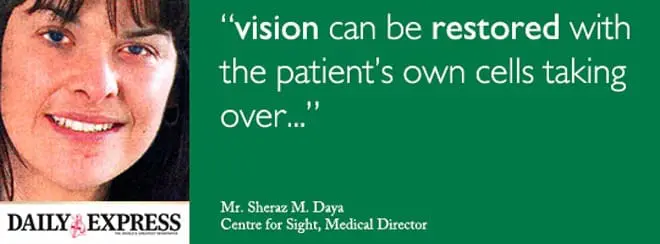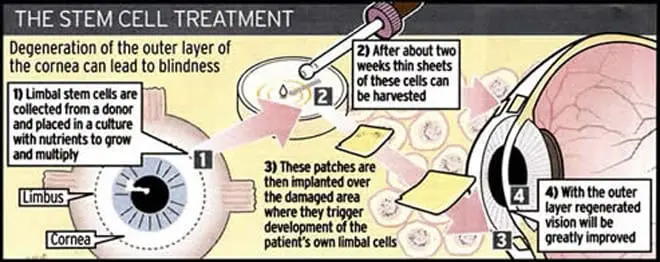Stem cell surgery saved my sight – Daily Express

A pioneering cure for blindness is giving patients with failing vision a new lease of life.
Martyn Halle reports
A REVOLUTIONARY treatment saved the sight of nursery nurse Sarah Mansini just when she thought she was going blind. Eye specialists originally told the 29-year-old there was nothing they could do to save her sight.
She then went on to have ground-breaking stem cell surgery which has practically restored her vision.
Sarah was born with a genetic disease called aniridia, which means that her iris – the coloured part of the eye – was missing. People with this condition lack a layer of cells on the cornea – the eye’s surface – which results in permanent damage and eventual blindness.
With practically no sight in her left eye and impaired vision in her right, Sarah’s sight had become so bad that she was unable to read to the children at the nursery.
Knowing there was no cure for her condition, she had resigned herself to going blind. Her luck changed when she was put in touch with consultant Sheraz Daya who has developed a cure for corneal blindness by using specially manufactured stem cells taken from eyes of living or dead donors.
Patients suffering from corneal blindness typically lack limbal stem cells for the top layer of the cornea, the epithelium, which act as a barrier against dust and germs. Without this tissue the cornea becomes irregular, destroying vision and leaving the eye prone to infection.
Mr Daya and workers at the Blond McIndoe research centre in East Grinstead, West Sussex, stunned the world of eye surgery by cultivating “sheets” of human stem cells in his laboratory and transplanting these to patients, restoring their sight.
Cells are obtained from the limbus, part of the junction where the white part of the eye meets the transparent cornea. They are then placed in a culture made from a number of nutrients to encourage them to grow into sheets. After two or three weeks the sheets are about two layers thick and are ready for transplantation.
Once implanted in the eye, the cells, known as limbal stem cells, seem to help trigger the production of the patient’s own cells, which ultimately results in improved vision.
“Using DNA fingerprinting we have demonstrated that vision can be restored with the patient’s own cells taking over,” says Mr Daya. “Somehow the stem cell transplant seems to get the body to start making limbal stem cells.”
Before starting the research Mr Daya was concerned that patients would have to take long-term anti-rejection drugs but a number of patients have demonstrated long-term success without the need for toxic drugs.”
“Before we transplant we scrape off the material that has grown over the eye,” he adds. “We lay the stem cell sheet on top and then cover them with amniotic membrane which acts as a biologic dressing for a short period of time. This contains substances that help the cells multiply. The patients are given eye drops made from their own blood plasma, which also helps the cells to grow.
“The results are quite dramatic. Most patients’ vision improves within weeks and we are really encouraged by how well our patients can now see. Some were almost completely blind and others had lost most of their sight or were in danger of losing it.”
SARAH, who lives in Beaconfield, Buckinghamshire, was among the first four aniridia patients in a pioneering trial of limbal stem cell transplantation when her right eye was treated by Mr Daya.
Within a matter of weeks her vision had improved to such an extent that she was able to start reading again. She now has about 75 per cent vision in her right eye.
“I was effectively blind before as all I could see were shapes and light,” says Sarah. “I would have lost all decent vision within a couple of years.”
The procedure is used to restore the ocular surface and top layer of the cornea. Once the layer is restored vision improves and the amount of restoration depends on the state of the eye at the time and how clear the cornea is.
Sarah still only has 50 per cent vision in her left eye and it is rapidly deteriorating. Mr Daya plans to perform the same procedure on it.
“The transplant has transformed my life and once I have both eyes treated I will have reasonably good vision,” she says.
Sarah is just one of 5,000 patients in the UK who could be saved from corneal sight loss by limbal stem cell transplantation and with further research, eye specialists are optimistic that the revolutionary surgery could be developed to cure other types of blindness.

Author Information
Authored by Sheraz Daya MD FACP FACS FRCS(Ed) FRCOphth, Consultant Ophthalmic Surgeon & Medical Director, June 2019.
Next review due August 2025